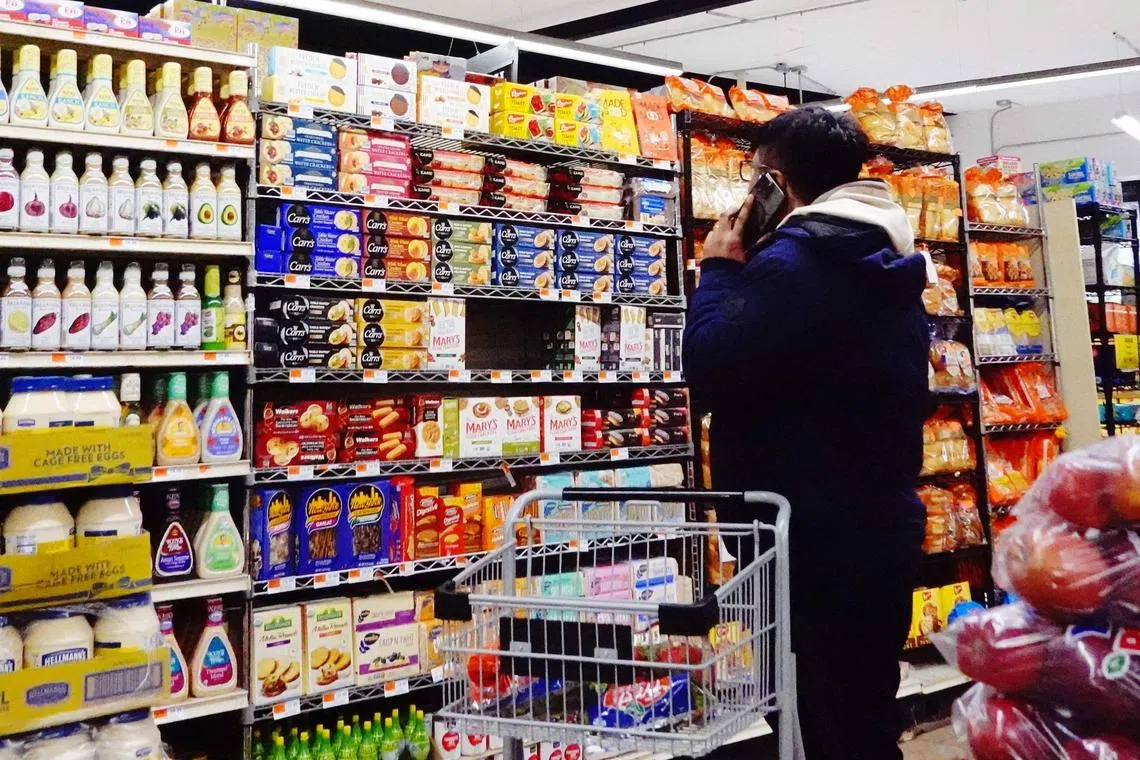World economy walks tightrope between recession and soft landing
Sign up now: Get ST's newsletters delivered to your inbox

The ebbing of inflation will support the purchasing power of consumers who spent much of last year squeezed by rising prices.
PHOTO: AFP
Follow topic:
Washington – The world economy is beginning the new year on a more optimistic note, although that is no guarantee 2023 will end that way.
A variety of factors – a sooner-than-expected reopening of China’s economy, warmer-than-normal winter in energy-strapped Europe
But with the Federal Reserve, European Central Bank (ECB) and several peers still pushing ahead with higher interest rates, the risk of a slump later in the year cannot be dismissed, especially if inflation proves sticky and does not retreat as much as central banks want.
“There is a narrow path to a soft landing,” Goldman Sachs chief economist Jan Hatzius told a Jan 11 webinar. “It is going to be difficult for policymakers to calibrate the amount of restraint to get that done.”
He is betting they will succeed – and so, too, are investors. Emerging market equities are on a tear and corporate bond prices are rising on hopes that the world economy will emerge from the scariest inflation in decades without suffering a downturn.
There are some reasons for guarded optimism. Price pressures are easing worldwide, in part because global growth has slowed but also due to an untangling of supply chains that were tied in knots by the pandemic and Russia’s invasion of Ukraine. US consumer prices rose 6.5 per cent in December from a year earlier, down from a high of 9.1 per cent in June.
The ebbing of inflation will support the purchasing power of consumers who spent much of 2022 squeezed by rising prices, especially for essentials such as energy, food and rents. It will also allow central banks to scale back their rate increases, dampening fears among investors that policymakers will go too far and “break something” in the markets.
Fed chair Jerome Powell and his colleagues are expected to downshift to a rate rise of a quarter percentage point at their Jan 31 to Feb 1 policy meeting, according to trading in the federal funds futures market. This would follow a half-point increase in December and four 75-basis-point moves before that.
The step back has led to a reversal of the US dollar’s meteoric rise, easing pressure on other central banks to match the Fed with economy-slowing rate increases of their own.
“We have seen peak dollar strength,” Kroll Institute global chief economist Megan Greene said.
Other pluses: Labour markets remain remarkably resilient, while household and business finances continue to enjoy some health.
When prices for energy, especially natural gas, surged in 2022, a recession in Europe was widely seen as a foregone conclusion. No longer: Mr Hatzius said he now sees the region dodging a downturn.
Credit mild winter weather and a concerted effort to boost supplies and expand suppliers to make up for lost imports from Russia. The result is that the euro-area economy has held up better than expected. Industrial production in Germany edged up last November, despite the country’s heavy dependence on Russian energy supplies.
“The danger of a complete economic meltdown, a core meltdown of European industry, has – as far as we can see – been averted,” German Economy Minister Robert Habeck said earlier in January.
Germany should also benefit from China abandoning its zero-Covid policy in favour of a reopening of its economy, a major destination for the European country’s exports.
China forecasts
Wall Street economists are busily upgrading their forecasts for China’s growth following the dismantling of its zero-Covid curbs .
While China’s recovery faces hurdles, the combination of an easing real estate slump and more government support means the outlook is better than many anticipated as recently as the end of 2022.
“We are now expecting a kind of V-shaped recovery, as we have seen in many other economies that have been shut down because of Covid-19,” said Mr Hatzius of China’s prospects.
The China reopening, though, could complicate the global inflation story by stoking demand – and prices – for oil and other commodities. This could then have implications for the Fed and other major central banks.
US jobs
Hopes that the Fed can rein in elevated inflation without crashing the economy into recession were boosted by the December jobs report, which showed wage gains easing while unemployment returned to a multi-decade low.
“It looks more like a soft landing,” Apollo Global Management chief economist Torsten Slok said.
Despite such budding optimism, the World Bank this week slashed its growth forecasts for most countries and regions, and warned that new shocks could still lead to a recession.
While the risk of a near-term global recession has diminished, there is still a 70 per cent chance of a slump later in 2023 or in 2024, according to JPMorgan Chase chief economist Bruce Kasman.
Price and cost pressures are likely to remain too persistent and elevated for the Fed and the ECB, setting the stage for an eventual end to the global expansion, he said.
“A recession is the more likely scenario down the road,” Mr Kasman said. BLOOMBERG

